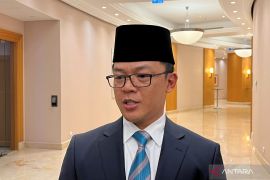Sorghum has yet to be fully planted in Indonesia because of various obstacles to understanding its benefit and the application of its cultivating technology.
Therefore, the campaigns to cultivate sorghum in the country need to be intensified in a bid to support the nation's food sufficiency program.
Farmers in Indonesia are now encouraged to start thinking about cultivating sorghum as an alternative staple diet, in order to reduce the countrys dependence upon rice and imported wheat.
As one of the top cereal crops, along with wheat, corn, rice, and barley, sorghum has been in use as a staple food in much of the developing world.
Sorghum is very high in fiber, iron, and protein, and is extremely tolerant to droughts.
Therefore, it is hoped that sorghum can be planted throughout the country to reduce dependence upon rice and imported wheat.
But so far, it has been planted in only a few districts, such as Gunung Kidul and Bantul in Yogyakarta, Belu in East Nusa Tenggara, South Lampung in Lampung, and Mukomuko in Bengkulu.
Sorghum has been planted three times in Gunung Kidul, with successful results because it is very water-use efficient.
Over the weekend, the Jati Makmur Farmers Group at Tepus sub-district in Gunung Kidul conducted a sorghum grand harvest.
Jati Makmur Farmers Group Chairman Marijan said in Gunung Kidul on Sunday that sorghum cultivation was becoming more popular among farmers, to be sold as a wholesome food and not just for animal feed.
"Sorghum grain consists largely of carbohydrates, good protein, vitamins and minerals, while having little fat and zero cholesterol, and supplies a lot of phosphorus, iron and potassium, significant amounts of magnesium and calcium, and even some zinc," he said.
According to Jati, sorghum provides energy, as well as builds and maintains healthy living cells, and is used for fighting off diseases, such as heart disease, cancer, diabetes, obesity and intestinal disorders.
"Therefore, if sorghum cultivation continues to be developed, it will be very helpful for farmers in improving their welfare and livelihood," he noted.
Meanwhile, Tepus sub-district head Suyatna said the sorghum harvest at Purwodadi village in Tepus sub-district was successful, and that, it was expected to become a milestone of potential local food recovery.
"The people now are relying heavily on rice, so they forget the classical foods, such as corn rice, and tiwul, a type of cake eaten with grated coconut, and sorghum," he said.
Suyatna also noted that food made of sorghum grain is very healthy because it is low in calories.
"We hope the success of sorghum cultivation in Purwodadi village in Gunung Kidul can raise peoples awareness about consuming local staple diets, particularly sorghum," he noted.
According to the Indonesian Agency for Agricultural Research and Development (IAARD) at the Ministry of Agriculture, as stated on its website, sorghum is a potential cereal crop that can be developed to support food sufficiency programs.
Further, it said sorghum is resistant to poor lands, can grow on sloping ground, is more resistant to pests and diseases, and is a multifunctional crop because all parts of it can be utilized as food, animal feed, and bio-ethanol.
The chemical composition of sorghum, which is similar to rice or flour, is an indication that it can be a substitute for rice because of its high nutritional value.
Sorghum flour can also be used to make cakes, cookies, and industrial raw materials, while its stem juice is a source of bio-ethanol, while the waste of the stem and leaves can be used as animal feed.
Sorghum that has been processed into ethanol can be used as a substitute for kerosene fuel with an ethanol content of 40-60 percent, for laboratory and pharmaceutical needs at 70-90 percent, and as premium fuel substitute at 90-100 percent.
Ethanol-producing plants, now cultivated in a relatively limited scale, in particular those producing fuel instead of kerosene, have been developed in several areas in Java, with the potential to produce 100-200 liters per hectare.
In Bantul district, farmers have been cultivating sorghum as a multifunctional crop over the past several years on some 400 hectares of land.
Therefore, local agriculture and forestry department chief Edy Suhariyanta said the Ministry of Agriculture, in 2013, provided 400 hectares of land for farmers to develop sorghum, as a follow up to the 2012 program of 50 hectares.
Edy noted that sorghum was a food crop commodity and, therefore, there would be an addition of 400 hectares of land for farmers to plant.
He said each group of farmers received Rp2.5 million to open new land and purchase fertilizer and sorghum seeds to develop idle and half idle lands in the district for sorghum plantation areas.
Further, he said Bantul has wide idle areas in the villages of Poncosari, Srandakan, Sedayu, Bambanglipuro, Pleret, Imogiri and Pajangan where sorghum plantations could be developed.
Realizing the importance of sorghum cultivation to support food sufficiency programs, State Enterprises Minister Dahlan Iskan initiated a sorghum planting movement in early 2013 on 200 hectares of land in Atambua, Belu district, East Nusa Tenggara province.
In reality, the sorghum planting program initiated by the minister, as part of Environmental Partnership Programs and Community Development (PKBL) to increase local peoples food resources, yielded a successful harvest later in August the same year.
Speaking at the harvest event in Atambua in August 2013, Dahlan said that with the successful harvest, PT Bogasari Flour Mills company was ready to purchase sorghum for use as flour from local farmers, no matter how large the harvest was.
With great enthusiasm, Dahlan added, "Even if sorghum flour in Belu is as high as a mountain, PT Bogasari and other flour mills are ready to buy it."
He noted that Atambua has barren land, which is unsuitable for growing rice and corn, but is adequate for growing sorghum. In fact, sorghum grows well in arid and dry areas because of its adaptation to extreme weather conditions.
The minister explained that the sorghum that was planted on 200 hectares of land could feed one thousand households.
He pointed out that besides the seeds, the stalks of the plant could be harvested and crushed like sugar cane to produce sorghum syrup.
Dahlan added that the State Enterprises Ministry was training about 40 students in vocational high schools in the East Nusa Tenggara provincial city of Kupang to build a sorghum pressing machine.
According to Belu district head Joachim Lopez, the sorghum planting movement was part of the effort to turn the district into the nations sorghum producing center.
"State Enterprises Minister Dahlan Iskan has become the motivator who challenges Belu district government and farmers to cultivate sorghum in the area," Lopez said.
He noted that for the first phase, sorghum was planted on 200 hectares of land in Weliman and Wewiku sub-districts, and would soon be developed, as well in the districts of Timor Tengah Selatan and Kupang, East Nusa Tenggara. (*)
Reporter: Otniel Tamindael
Editor: Otniel Tamindael
Copyright © ANTARA 2014











